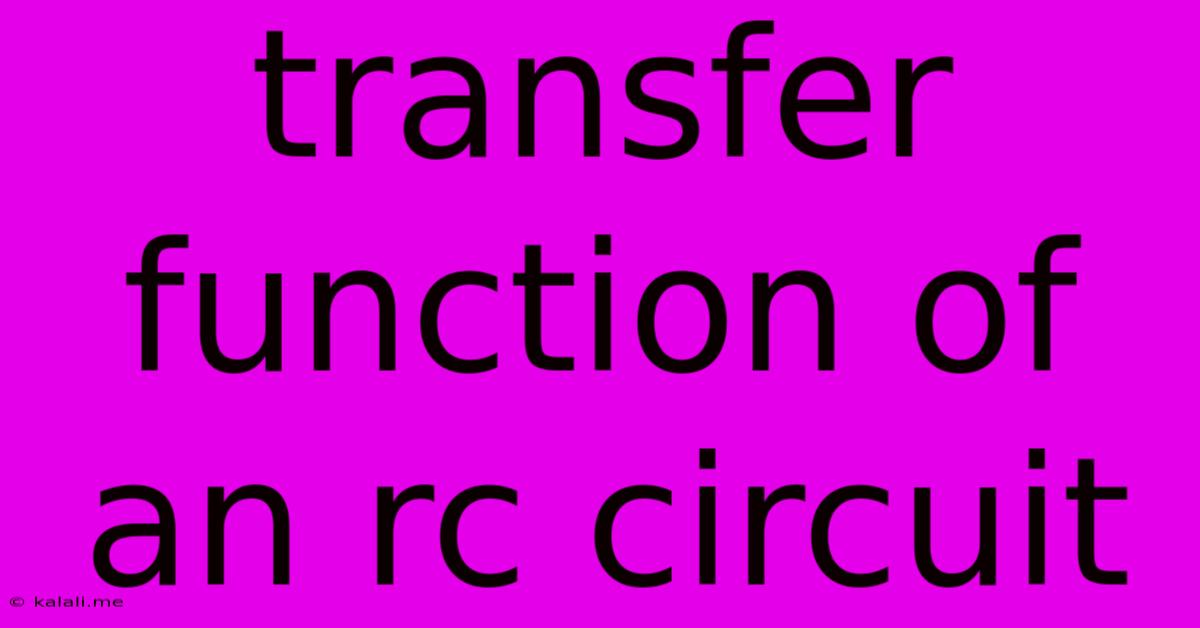Transfer Function Of An Rc Circuit
Kalali
May 25, 2025 · 3 min read

Table of Contents
Understanding the Transfer Function of an RC Circuit
The RC circuit, a fundamental building block in electronics, consists of a resistor (R) and a capacitor (C) connected in series or parallel. Understanding its transfer function is crucial for analyzing its behavior in various applications, from simple filters to complex signal processing systems. This article will delve into the derivation and interpretation of the RC circuit's transfer function, exploring both its frequency and time-domain responses.
What is a Transfer Function?
A transfer function describes the relationship between the output and input of a linear time-invariant (LTI) system. In simpler terms, it shows how a system modifies or transforms an input signal to produce an output signal. For an RC circuit, the input is typically a voltage source, and the output is the voltage across either the resistor or the capacitor. The transfer function is often represented in the Laplace domain (s-domain) using the complex frequency variable 's'.
Derivation of the Transfer Function for a Series RC Circuit
Let's consider a series RC circuit with input voltage V<sub>in</sub>(s) and output voltage V<sub>out</sub>(s) across the capacitor. Using impedance analysis in the Laplace domain:
- Impedance of the resistor: R
- Impedance of the capacitor: 1/(sC)
The total impedance Z(s) is the sum of the individual impedances: Z(s) = R + 1/(sC)
Using voltage division, the output voltage across the capacitor is:
V<sub>out</sub>(s) = V<sub>in</sub>(s) * [1/(sC)] / [R + 1/(sC)]
Simplifying this expression, we get the transfer function H(s):
H(s) = V<sub>out</sub>(s) / V<sub>in</sub>(s) = 1 / (1 + sRC)
This is a first-order low-pass filter. The transfer function shows how the circuit attenuates higher frequencies and passes lower frequencies.
Interpreting the Transfer Function
-
DC Response (s = 0): As s approaches 0 (DC), H(s) approaches 1. This means that DC signals pass through the circuit without attenuation.
-
High-Frequency Response (s → ∞): As s approaches infinity (high frequencies), H(s) approaches 0. This indicates that high-frequency signals are significantly attenuated.
-
Cut-off Frequency (ωc): The cut-off frequency, also known as the corner frequency, is the frequency at which the magnitude of the transfer function is reduced by 3dB (approximately 0.707). For the series RC circuit, ωc = 1/(RC). This frequency marks the transition between the passband and stopband.
-
Time Constant (τ): The time constant, τ = RC, represents the time it takes for the capacitor voltage to reach approximately 63.2% of its final value in response to a step input. It's a key parameter characterizing the transient response of the circuit.
Parallel RC Circuit Transfer Function
For a parallel RC circuit, where the output voltage is taken across the resistor, a similar analysis yields a different transfer function:
H(s) = V<sub>out</sub>(s) / V<sub>in</sub>(s) = sRC / (1 + sRC)
This is a first-order high-pass filter, passing high-frequency signals and attenuating low-frequency signals. Its cutoff frequency is still 1/(RC).
Applications of RC Circuits and their Transfer Functions
RC circuits and their transfer functions find wide applications in various electronic systems, including:
- Simple Filters: Low-pass and high-pass filters for signal conditioning.
- Coupling and Decoupling Circuits: Isolating different parts of a circuit.
- Timing Circuits: Generating time delays or pulses.
- Integration and Differentiation: Performing mathematical operations on signals.
Understanding the transfer function of an RC circuit provides valuable insights into its behavior and allows engineers to design and analyze circuits for specific applications. By manipulating the values of R and C, the characteristics of the filter, such as cutoff frequency and time constant, can be precisely controlled. This fundamental concept extends to more complex circuits and systems, forming the basis of signal processing and control theory.
Latest Posts
Latest Posts
-
How To Get Rust Stains Out Of Concrete
May 25, 2025
-
Getting Rid Of Mold On Wood
May 25, 2025
-
How To Obtain A Survey Of Your Property
May 25, 2025
-
How To Remove Hearts On Minecraft Op
May 25, 2025
-
What Gauge Wire For 15 Amp
May 25, 2025
Related Post
Thank you for visiting our website which covers about Transfer Function Of An Rc Circuit . We hope the information provided has been useful to you. Feel free to contact us if you have any questions or need further assistance. See you next time and don't miss to bookmark.